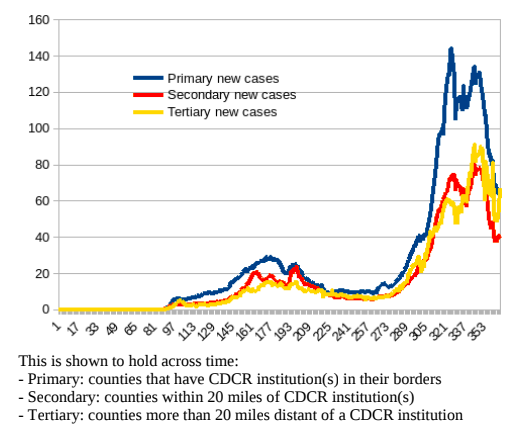
In the aftermath of the upsetting removal of prison populations from Tier 1B of vaccination in CA, and the horribleness of the Colorado debate over vaccinating in prisons, come more unscientific blends of public health and deservedness. Another version of this is the nauseating “inmates-before-Grandma” soundbite from Wisconsin. And today, we hear that Tennessee has scheduled its prison population last in line, because a state advisory panel tasked with deciding in what order residents should receive the COVID-19 vaccine, which acknowledged that prison populations were high-risk, concluded that prioritizing them for inoculation could be a “public relations nightmare.” Kimberly Kruesi and Jonathan Mattise of the Associated Press report:
Documents from the meetings of the Pandemic Vaccine Planning Stakeholder group, did, in fact, stress the importance of the general public seeing that inmates “are people” who should be treated as “part of the community” and “if untreated they will be a vector of general population transmission.” Yet the documents concede that providing the vaccine to inmates would result in “lots of media inquiries.”
The panel comprises roughly 40 public health agencies, lawmakers, health care coalitions, emergency management and other organizations. Because it serves in an advisory capacity it is not required under Tennessee law to meet publicly, and no audio recordings of the meetings exist, according to the Department of Health. The AP obtained the meeting notes through a public records request.
According to the documents, the group first met, virtually, on Sept. 22, before vaccines were available. Tennessee’s incarcerated population came up during that meeting, when the committee talked about populations that may have been overlooked.
“Understand it would be a (public relations) nightmare but a possible liability to the state,” states one document, which is not attributed to anyone by name.
Later, in December, when the group met to discuss moving up certain age groups, as well as teachers, inmates were once again considered.
“If we get hit hard in jails it affects the whole community. Disease leaves corrections facilities and reenters general society as inmates cycle out of their sentencing,” the document reads, adding that when inmates get the disease “it is the taxpayers that have to absorb the bill for treatment.”
Ultimately, corrections workers and jailers were bumped up to one of the earliest slots, alongside first responders. Meanwhile, inmates remained in the last eligible group. Even now, senior inmates who may qualify under the state’s age qualifications are still not getting immunized.
I’m not only disgusted, but puzzled. Do people in Tennessee (and Wisconsin, and Colorado, and apparently now California) not understand (1) how prisons work or (2) how contagion spreads? Chapter 5 of our book-in-progress Fester: Carceral Permeability and the California COVID-19 Prison Disaster relies on modeling, some our own based on primary data and some developed by others, to show that tackling the outbreaks in prisons should be a priority not just from a humanitarian standpoint, but also from a sheer selfish perspective.
Consider the graph above, which shows infections over time in three groups of California counties: Counties with prisons in them, counties within 20 miles of prisons, and counties farther away. The waves of infection are clearly visible, not only in the sense that more distant counties have fewer cases, but also in that the outbreaks there occur later.
Consider also this more general graph of CDCR infections and overall state infections:

Our data shows that peaks in state infections closely follow (by “closely” we mean, a delay of about 14 days) peaks in prison infections. We can also show that the number of CDCR facilities within a given county correlates with the infection rate in the county:

Over the last few days, people of various political persuasions have talked with me about this, making some variation or other of the argument that “taxpaying, honest folks should be first in line.” Rather than launching into schoolmarmish scolding of their morals (tempting as it was), all I did was show them these three graphs. Vaccinating “inmates-before-Grandma” does not mean “inmates-at-the-expense-of-Grandma.” Eliminating Petri dishes for the virus is beneficial to everyone.




No comment yet, add your voice below!